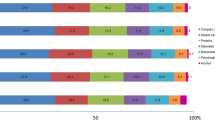Abstract
The purpose of this study was to identify dietary patterns among adults in Québec and to determine their relationship to nutritional adequacy of the diet. We used 24-hour food recall data on 2,104 adults from the Québec nutrition survey (1990). Nutritional adequacy was assessed based on the 1990 Nutrition Recommendations for Canadians; dietary patterns were assessed via a factor analysis of the 30 food groups consumed. The three major patterns identified (‘high-energy density’, ‘traditional’ and ‘health-conscious’) explained 18% of the variation in food intake. Only the ‘health-conscious’ pattern correlated positively with the four chosen indicators of nutritional adequacy. Generally, men scored positively on the ‘high-energy density’ and the ‘traditional’ pattern whereas women scored positively on the ‘health-conscious’ pattern. Aside from sex, scoring was most related to age and education. The use of these patterns to define and target nutrition interventions should be tested in the aim of improving the effectiveness of health promotion.
Résumé
Cette étude visait à identifier les habitudes alimentaires de la population adulte du Québec et à vérifier leur relation avec la qualité nutritionnelle de l’alimentation. Nous avons utilisé les rappels alimentaires de 24 heures effectués chez 2 104 adultes lors de l’enquête provinciale sur la nutrition (1990). La qualité nutritionnelle a été déterminée en fonction des Recommandations sur la nutrition de 1990 et des habitudes alimentaires par une analyse factorielle des 30 groupes d’aliments consommés. Les principaux habitudes identifiés (‘densité énergétique élevée’, ‘traditionnel’, et ‘santé’) expliquaient 18 % de la variance dans l’apport alimentaire. Seul l’habitude ‘santé’ était corrélé positivement avec les quatre indicateurs de la qualité nutritionnelle retenus. Généralement, les hommes avaient un résultat positif pour les habitudes ‘densité énergétique élevée’ et ‘traditionnel’ et les femmes pour l’habitude ‘santé’. Outre le sexe, les scores ont surtout varié en fonction de l’âge et du niveau d’éducation. L’utilisation de ces habitudes pour définir et cibler des interventions en nutrition devrait être testée en vue d’améliorer les efforts de promotion de la santé.
Similar content being viewed by others
References
Schwerin HS, Stanton JL, Riley AM, et al. Food eating patterns and health: A reexamination of the Ten-State and HANES I surveys. Am J Clin Nutr 1981;34:568–80.
Schwerin HS, Stanton JL, Smith JL, et al. Food, eating habits, and health: A further examination of the relationship between food eating patterns and nutritional health. Am J Clin Nutr 1982;35:1319–25.
Gex-Fabry M, Raymond L, Jeanneret O. Multivariate analysis of dietary patterns in 939 Swiss adults: Sociodemographic parameters and alcohol consumption profiles. Int J Epidemiol 1988;17(3):548–55.
Nicklas TA, Webber LS, Thompson B, Berenson GS. A multivariate model for assessing eating patterns and their relationship to cardiovascular risk factors: The Bogalusa Heart Study. Am J Clin Nutr 1989;49:1320–27.
Gregory J, Foster K, Tyler H, Wiseman M. The Dietary and Nutritional Survey of British Adults. London: HMSO Books, 1990; 209–17.
Randall E, Marshall JR, Graham S, Brasure J. Patterns in food use and their associations with nutrient intakes. Am J Clin Nutr 1990;52:739–45.
Randall E, Marshall JR, Brasure J, Graham S. Patterns in food use and compliance with NCI dietary guidelines. Nutr Cancer 1991;15:141–58.
Randall E, Marshall JR, Brasure J, Graham S. Dietary patterns and colon cancer in Western New York. Nutr Cancer 1992;18:265–76.
Gallagher ML, Farrior E, Broadhead L, et al. Development and testing of a food frequency recall instrument for describing dietary patterns in adults and teenagers. Nutr Res 1993;13:177–88.
Nolan CC, Gray-Donald K, Shatenstein B, O’Loughlin J. Dietary patterns leading to high fat intake. Can J Public Health 1995;86:389–91.
Hair JF, Anderson RE, Tatham RL, Black WC. Multivariate Data Analysis with Readings Third ed. New York: MacMillan, 1987.
Beaudry M, Galibois I, Chaumette P. Assessing the quality of food intake with the 1990 nutrition recommendations: Four indicators proposed. J Can Diet Assoc 1996;57(1):7–11.
Sokal RR, Rohlf FJ. Biometry: The Principles and Practice of Statistics in Biological Research 2nd ed. San Francisco: WH Freeman, 1981.
Author information
Authors and Affiliations
Corresponding author
Additional information
This work was partially funded by a grant from the Dairy Farmers of Canada (1993–95).
Rights and permissions
About this article
Cite this article
Beaudry, M., Galibois, I. & Chaumette, P. Dietary Patterns of Adults in Québec and their Nutritional Adequacy. Can J Public Health 89, 347–351 (1998). https://doi.org/10.1007/BF03404489
Received:
Accepted:
Published:
Issue Date:
DOI: https://doi.org/10.1007/BF03404489




